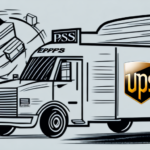Understanding Shipping Rates Through UPS
Shipping products and goods is an essential part of many business operations. It allows companies to reach customers worldwide, expand their market share, and increase revenue. However, shipping costs can significantly impact profits, especially for small businesses without the same negotiating power as larger companies. That's where UPS becomes a reliable and trusted shipping partner for businesses of all sizes. In this comprehensive guide, we'll explore UPS shipping rates, how they work, and strategies to optimize your shipping budget.
Calculating Shipping Costs for UPS Deliveries
UPS shipping rates are determined by several factors, including the distance between the origin and destination, the weight and dimensions of the package, the shipping service selected, and any additional fees or surcharges. To estimate your shipping costs, you can utilize the UPS online calculator. This tool considers various elements such as delivery address, package dimensions, declared value, delivery date, and additional options. Alternatively, UPS provides comprehensive shipping rate charts that outline costs for different destinations, package sizes, shipping speeds, and services.
Decoding the Complexities of UPS Shipping Rates
Understanding UPS shipping rates can be challenging, especially for newcomers in the shipping industry. Rates can fluctuate based on market conditions, and minor variations in package details can significantly affect the final cost. Key factors influencing shipping rates include package weight and dimensions, delivery location and zip code, selected service type, and the declared value of the contents. By comprehending these elements, businesses can negotiate better rates with UPS and select the most cost-effective shipping options.
Seasonal fluctuations also play a role in UPS shipping rates. During peak periods like the holiday season, rates may increase due to higher demand. Proactive planning and budgeting for these potential rate hikes are crucial for maintaining profitability.
Staying informed about any changes in UPS rates is essential. UPS may adjust their pricing based on operational changes or broader market trends. Regularly reviewing UPS updates and industry reports can help businesses make informed decisions about their shipping strategies, ensuring they receive the best possible rates.
How to Estimate Shipping Charges with UPS
UPS offers a user-friendly online calculator that allows businesses to estimate shipping charges efficiently. By entering essential shipment details such as package weight, dimensions, destination zip code, and preferred shipping service, the calculator provides an estimated shipping cost, including applicable fees and surcharges. It's important to note that these estimates may vary based on real-time factors at the time of shipping.
UPS provides a variety of shipping services tailored to different needs. For expedited deliveries, services like UPS Next Day Air guarantee next-business-day delivery but at a higher cost. Conversely, UPS Ground offers more affordable rates with longer delivery times, suitable for less urgent shipments.
Beyond the online calculator, UPS offers a range of tools and resources to streamline shipment management. Features include creating shipping labels, real-time package tracking, and scheduling pickups from your business location, all of which enhance efficiency for frequent shippers.
A Comprehensive Guide to Understanding UPS Shipping Rates
UPS shipping rates encompass various components that can seem complex but are manageable with the right knowledge. Key factors to consider include the type of service selected, package size and weight, shipping destination (domestic or international), and any additional fees or surcharges. Understanding these elements enables businesses to make informed shipping decisions that align with their operational needs and budget constraints.
UPS frequently offers discounts and promotions, such as volume shipping discounts, industry-specific rates, and seasonal promotions. Keeping abreast of these opportunities can lead to significant cost savings. Additionally, utilizing UPS's estimation and tracking tools can further optimize your shipping process, ensuring packages are delivered on time and within budget.
How to Determine the Best UPS Shipping Option for Your Business
Choosing the optimal UPS shipping option depends on factors like package size and weight, destination, delivery timeframes, and budget. UPS provides various shipping methods, including ground shipping, air shipping, and international shipping, each with distinct advantages and considerations. By evaluating the specific requirements of your shipments, you can select the most cost-effective and efficient shipping option.
Consider the level of tracking and insurance necessary for your shipments. UPS offers different tracking features and insurance options to protect valuable packages. Additionally, utilizing UPS's branded packaging solutions, such as boxes and envelopes, can enhance the safety and presentation of your shipments.
The Factors That Affect UPS Shipping Rates
Several factors influence UPS shipping rates, including:
- Package Weight and Size: Heavier and larger packages typically incur higher shipping costs.
- Delivery Distance: Longer shipping distances can increase rates.
- Shipping Service: Faster delivery services are generally more expensive.
- Delivery Date: Specific delivery dates, especially during peak seasons, may affect rates.
- Additional Services: Options like signature confirmation, Saturday delivery, and insurance add to the cost.
- Surcharges and Fees: Additional charges may apply based on package characteristics or shipping requirements.
By considering these factors, businesses can better estimate shipping costs and make informed decisions to optimize their shipping strategies.
Tips for Reducing Your Shipping Costs with UPS
Reducing shipping costs with UPS can enhance your business's profitability. Here are several strategies to consider:
- Ship in Bulk: Taking advantage of volume discounts can lower per-package shipping costs.
- Optimize Packaging: Use appropriately sized packaging to minimize both weight and dimensional weight charges.
- Consolidate Shipments: Combining multiple orders into a single shipment reduces the total number of packages.
- Schedule in Advance: Planning shipments ahead of time can help secure better rates.
- Negotiate with UPS: Establishing a relationship with UPS and negotiating based on shipping volume can lead to lower rates.
Understanding the Different Types of UPS Shipping Services
UPS offers a variety of shipping services tailored to different business needs and delivery requirements. Common services include:
- Ground Shipping: Cost-effective for non-urgent deliveries within the U.S.
- Air Shipping: Faster delivery options, such as Next Day Air, for urgent shipments.
- International Shipping: Services like UPS Worldwide Express for global deliveries.
- Freight Shipping: Suitable for large or heavy shipments.
- Same-Day Delivery: Immediate delivery options for urgent needs.
Each service varies in terms of speed, cost, and package size limitations. Understanding these differences allows businesses to select the most appropriate service for each shipment.
How to Negotiate Better Rates with UPS for Your Business
Negotiating better rates with UPS can lead to substantial cost savings for businesses. Here are some strategies to consider:
- Leverage Shipping Volume: Businesses that ship frequently and in large volumes have greater bargaining power.
- Understand Competitor Rates: Being informed about the rates and services of UPS's competitors can aid in negotiations.
- Utilize a Shipping Consultant: Experts can assist in navigating negotiations and securing favorable terms.
Building a strong relationship with UPS and clearly communicating your shipping needs and volumes can also facilitate better rate agreements.
Comparing UPS Shipping Rates with Other Carriers
Comparing UPS shipping rates with those of other carriers ensures you're receiving the best value and service for your business needs. Key factors to evaluate include package size and weight, delivery speed, destination, and any additional surcharges or fees. Major competitors to UPS include FedEx, DHL, and the United States Postal Service (USPS). By analyzing the rates and services of these carriers, businesses can make informed decisions and select the most cost-effective shipping option.
Understanding Additional Fees and Surcharges in UPS Shipments
Beyond the base shipping rates, UPS imposes various fees and surcharges based on specific package characteristics or shipping requirements. Common fees include:
- Address Correction Fees: Applied when shipment addresses require correction.
- Residential Delivery Fees: Charged for deliveries to residential addresses.
- Fuel Surcharges: Additional costs reflecting fluctuating fuel prices.
- Dimensional Weight Surcharges: Applied to large, lightweight packages based on their volume.
Understanding these fees is crucial for accurately predicting and managing your UPS shipping costs.
The Impact of Dimensional Weight on Your UPS Shipping Rates
Dimensional weight (DIM weight) is a pricing method UPS uses to account for the space a package occupies in relation to its actual weight. Calculated based on the package's volume, DIM weight can result in higher shipping costs for oversized yet lightweight packages. To minimize DIM weight charges, businesses can:
- Optimize Packaging: Use appropriately sized boxes and avoid excessive void space.
- Choose Suitable Shipping Options: Select services that better accommodate larger packages.
By managing DIM weight effectively, businesses can reduce their overall shipping expenses.
How to Use the UPS Online Calculator to Determine Your Shipping Costs
The UPS online calculator is an essential tool for businesses to estimate shipping costs accurately. To utilize the calculator:
- Navigate to the UPS shipping calculator page.
- Enter the necessary package details, including weight, dimensions, origin, and destination addresses.
- Select the desired shipping service and any additional options.
- Review the estimated shipping cost, including any applicable fees and surcharges.
This estimate aids in budgeting and comparing shipping options to find the most cost-effective solution.
The Importance of Proper Packaging in Reducing Your UPS Shipping Rates
Proper packaging plays a crucial role in minimizing UPS shipping rates. By optimizing packaging, businesses can reduce both the size and weight of packages, thereby lowering shipping costs. Additionally, well-packaged items are less prone to damage during transit, reducing the risk of returns and customer dissatisfaction. Tips for effective packaging include:
- Select the Right Box Size: Use boxes that fit your products snugly to avoid unnecessary space.
- Use Cushioning Materials: Protect items with appropriate padding to prevent damage.
- Reinforce Package Edges: Strengthen boxes to withstand handling during transit.
- Properly Seal Packages: Ensure all packages are securely sealed to maintain integrity.
Implementing these packaging strategies can lead to significant savings on UPS shipping costs while ensuring product safety.
In conclusion, understanding UPS shipping rates is vital for any business that relies on shipping products and goods. By comprehending the various factors that influence shipping costs, businesses can make informed decisions that enhance efficiency and profitability. Explore all available shipping options, negotiate favorable rates with UPS, and optimize your packaging to reduce shipping expenses, ultimately supporting your business's growth and success.




















